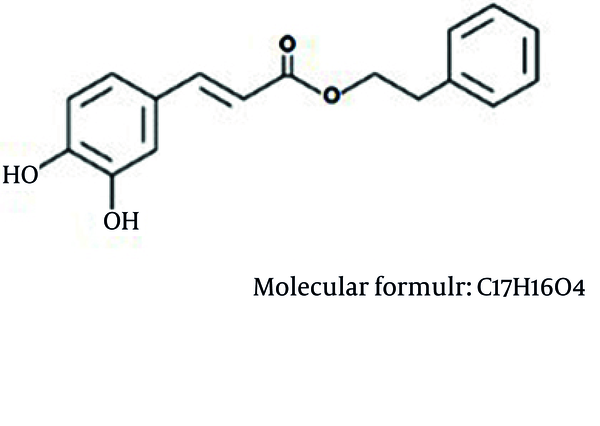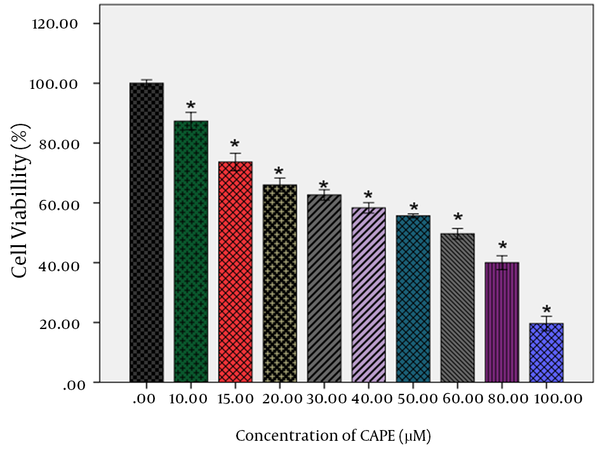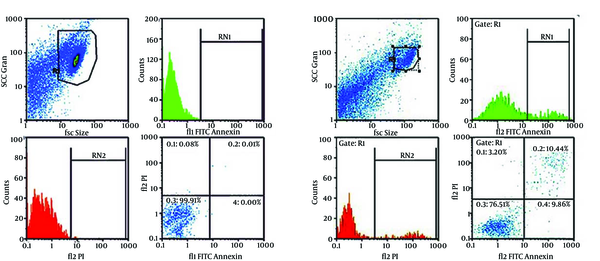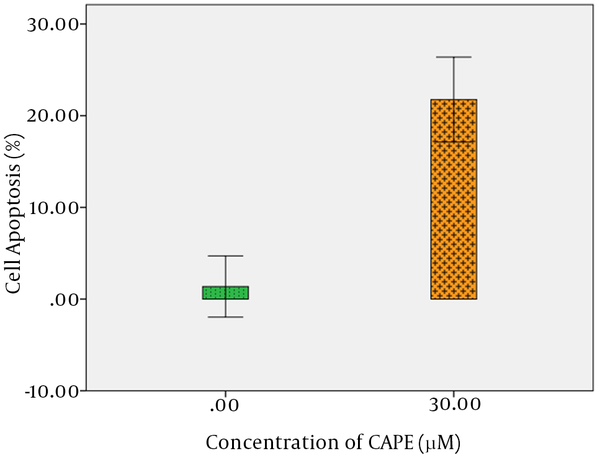Abstract
Background:
Propolis is a natural product of bee and caffeic acid phenethyl ester (CAPE) is a pharmacologically important product of propolis.Objectives:
The aim of this study was to investigate the effect of CAPE on apoptosis induction in AGS human gastric cancer cells.Materials and Methods:
The cytotoxic effects of CAPE at different concentrations were investigated on AGS cells viability after 24 hours treatment by MTT assay. To measure the effect of CAPE on apoptosis induction, AGS cells were treated with CAPE for 24 hours and investigated by FITC Annexin V/PI staining using flow cytometry.Results:
CAPE prevented growth and proliferation of AGS human gastric cancer cell line in a concentration-dependent manner with an IC50 of approximately 60 µM by a 24-hour treatment. Also CAPE caused increased induction of apoptosis in AGS cells from 1.37 % in control cells to 21.76 % in treated cells with 30 µM CAPE.Conclusions:
CAPE prevents growth and proliferation of AGS human gastric cancer cell line through inducing programmed cell death in AGS cells. Therefore, CAPE could be helpful for developing chemotherapeutic agents or as an adjuvant for human gastric cancer treatment.Keywords
1. Background
Gastric cancer is the fourth prevalent cancer and the second reason for cancer-associated mortalities worldwide (1, 2). Chemotherapy is frequently used as a primary treatment for gastric cancer. The main obstacle facing success of chemotherapy is multidrug resistance (MDR), which is characterized by resistance to chemotherapeutic agents after exposure to a chemotherapy drug (3). One of the most important factors contributing to MDR to chemotherapeutic agents is disruption in apoptosis process (4).
Cancers accompanied with changes in proteins that participate in cell death signaling are often resistant to chemotherapy and difficult to be treated by chemotherapeutic agents which function fundamentally through apoptosis induction (5). In gastric cancer, as with other cancers, apoptosis process is disrupted so that it is associated with severe disturbance in BAX/BCL2 system accompanied with a pronounced increase in BCL2 expression (6), loss of APAF-1 expression (7) and inactivating mutation or loss of heterozygosity (LOH) of the caspase 10 gene (8). In addition, p53, p21, Bax and Bcl-2 factors involved in regulation of apoptosis cascades are disturbed in some types of gastric cancer (6, 9, 10). In addition, expression and activity of nuclear factor- κB (NF-κB) transcription factor is pronouncedly increased in human gastric cancer (11). Infection with Helicobacter pylori CagA+ enhanced NF-κB activity (12). Any disturbance in NF-κB activity has been demonstrated to increase proliferation, evasion of apoptosis, genomic instability, increased glycolysis rate and drug resistance in gastric cancer cells, as well as to facilitate tumor invasion and expansion (13-16). Therefore, because of disruption in apoptotic pathways and MDR to chemotherapeutic drugs in gastric cancer, promoting cancer cells toward apoptosis is a useful and practical method of preventing cancer and treating gastric cancer. Moreover, development of drugs aimed to inverse programmed cell death could work against cancer.
More than 60% of anticancer drugs have been directly or indirectly obtained from natural sources (17). Recent studies have shown promising findings on natural products for treatment and prevention of cancer (18, 19). Propolis is a natural product and a promising source for discovering new drugs (20). Caffeic acid phenethyl ester (CAPE) is an active component of propolis, a resinous mixture obtained from honeybee hives. CAPE was synthesized in 1988 at Columbia University (21) and later found to be a potent anti-cancer ingredient in propolis (22-24). It has important biological activities including antibacterial, antiviral, anti-inflammatory, and NF-κB-inhibitory (25-32).
Molecular Structure of CAPE

2. Objectives
The aim of this study was to investigate cytotoxic effect of CAPE and its potential on apoptosis induction in AGS human gastric cancer cells.
3. Materials and Methods
3.1. Chemical and Reagent
Culture medium of Dulbecco’s Modified Eagle’s medium (DMEM), fetal bovine serum (FBS), penicillin-streptomycin and trypsin-EDTA were purchased from Gibco Co (Invitrogen, Carlsbad, CA, USA). CAPE and dimethyl sulfoxide (DMSO) were purchased from Sigma Chemical Co. (St. Louis, MO, USA). MTT (3-(4, 5-dimethylthiazol-2-yl)-2, 5-diphenyltetrazolium bromide) Assay Kit was purchased from BIO IDEA Co (Tehran-Iran). FITC Annexin V Apoptosis Detection Kit I obtained from BD Biosciences (Pharmingen, San Diego, CA, USA). CAPE at 100 mmol/mL concentration was dissolved in DMSO as solvent and stored in 100 µL volume at -20°C temperature.
3.2. Cell Culture
In this experimental study, AGS human gastric cancer cell line was purchased from the National Cell Bank of Iran (NCBI), Pasteur Institute of Iran (NCBI, C131). Cells were cultured in DMEM medium containing 10% FBS and 1% penicillin/streptomycin at 37°C temperature in a wet incubator containing 5% CO2. To maintain cells in the exponential growth phase, they were passaged twice a week. All tests were performed in approximately 80% cell confluence.
3.3. Cell Viability Assay
Cell viability was measured by MTT assay kit. The viability of AGS cells was measured in different concentrations of CAPE within 24 hours. Cells were seeded into 96 well plates at a density of 5×103 cells per well and plates were incubated at 37°C temperature in a humidified incubator containing 5% CO2 for 24 hours. After 24 hours, the medium was removed and the cells were treated for 24 hours with medium containing different (0, 10, 15, 20, 30, 40, 50, 60, 80, and 100 µM/mL) concentrations of CAPE. Cells not treated with CAPE were considered as control. Moreover, to neutralize the effect of DMSO, control groups were treated with DMSO 0.1% used as solvent for CAPE. Each CAPE concentration was represented by three wells and replicated thrice. After 24 hours, AGS cells viability was measured by MTT Assay kit according to manufacture protocol. Finally, optical density of each well was read by an ELISA reader (AWARENESS) at 570 nm wavelength and the rate of viability (%) was calculated by the following formula:

3.4. FITC Annexin V/PI Staining
Apoptosis cells were differentiated from live cells or cells undergoing necrosis by FITC Annexin V/PI staining using apoptosis assay kit. To investigate the effect of CAPE treatment on apoptosis induction, AGS cells were firstly cultured in six-well plates with 2 × 105 cells per well in 3.5 mL for 24 hours. After 24 hours, previous medium was removed and the cells with the same amount of culture medium containing 30 µM CAPE were treated for 24 hours. Cells not treated with CAPE and whose medium was replaced with new growth medium were used as control. To neutralize the effect of DMSO, control groups were treated with DMSO, used as CAPE solvent, at 0.1% concentration. The experiments were separately performed for control and treatment groups in three wells in triplicate. At the end of treatment time, adherent and floating cells were collected from both treatment and control groups, rinsed twice using cold PBS and centrifuged. Then, the cells were suspended in binding buffer at 1 × 106 cell per mL. 100 µL of the obtained solution, containing 1 × 105 cells, was transferred into another tube and stained with 5 µL of FITC Annexin V and 20 µL of PI according to apoptosis measurement kit protocol. After 15 minutes incubation of the cells at room temperature and in darkness, 400 µL of the binding buffer was added to the cells and the FITC Annexin V/PI-stained cells were analyzed by flow cytometry instrument (Partec, Germany) using 20,000 cells.
3.5. Statistical Analysis
Statistical analysis of data of MTT measurement for different concentrations of CAPE within 24 hours, calculated as viability (%), was performed by SPSS 19 (IBM Company, United States) using one-way ANOVA followed by Dunnett’s test. The data of apoptosis induction measurement was performed using t-test. P < 0.05 was considered as statistically significant.
4. Results
4.1. The Antiproliferative Effects of CAPE on AGS Cells
Analysis of data for AGS cells treatment with CAPE within 24 hours indicated that all treated CAPE concentrations decreased the AGS cells viability in a concentration-dependent manner (Table 1). Higher concentrations of CAPE decreased the viability of AGS cells more pronouncedly. For the cells treated with CAPE, IC50 obtained as approximately 60 µM. In addition, a pronounced decrease was observed in the viability of AGS cells treated with CAPE within 24 hours at 80- and 100-µM concentrations, so that the viability was obtained respectively 40% and 19.6% for these two concentrations. Statistical analysis of data on 24-hour treatment with CAPE by Dunnett’s test indicated a statistically significant difference between all treated concentrations and the control (P < 0.001). The effect of CAPE on viability of the AGS cells is illustrated in Figure 2.
Results of AGS Cells Viability Treated With Various Concentrations of the CAPE in 24 Hoursa,b
| Concentrations of CAPE, µM | Mean of cell viability |
|---|---|
| 0 | 100 |
| 10 | 87.3 |
| 15 | 73.6 |
| 20 | 66 |
| 30 | 62.6 |
| 40 | 58.3 |
| 50 | 55.6 |
| 60 | 49.6 |
| 80 | 40 |
| 100 | 19.6 |
AGS Cells Viability in 24-hour Treatment With CAPE

The effect of CAPE at 0, 10, 15, 20, 40, 30, 50, 60, 80 and 100 µM within 24 hours was investigated on viability of AGS human gastric cancer cells. Dunnett’s test indicated a significant difference between different concentrations of treatment and control within 24 hours.* P <0.001 versus vehicle.
4.2. Effect of CAPE on Apoptosis
For quantitative assay of CAPE effect on apoptosis induction, detection rate of phosphatidylserine (PS) as a marker of primary apoptosis in the outer membrane was measured by flow cytometry. Compared with the control group, CAPE induced primary apoptosis in AGS cells, so that after a 24-hour treatment of AGS cells with 30 µM CAPE, approximately 9.98% of cells were at primary apoptosis, while in the control group treated with 0.1% DMSO, approximately 0.37% of the cells were at primary apoptosis. In addition, the rate of secondary apoptosis induced by treatment with 30 µM CAPE for 24 hours was 11.78%, while the control group indicated 1% secondary apoptosis. Totally, the rate of apoptosis for treatment with 30 µM CAPE for 24 hours was 21.76%, while it was 1.37% for the control, with a statistically significant difference (P < 0.001) (Figure 3 A and B, Figure 4, and Table 2).
Aassessment of Apoptosis Using FITC Annexin V/PI in AGS Human Gastric Cancer Cell Line

Assessment of Apoptosis Using FITC Annexin V/PI in AGS Human Gastric Cancer Cell Line

| Experimental Groups | Control Groups | Treatment Groups |
|---|---|---|
| Early apoptosis | 0.37 | 9.98 |
| Late apoptosis | 1.01 | 11.78 |
| Total apoptosis | 1.37 | 21.76 |
The mean total apoptosis was measured by assessment of apoptosis using FITC Annexin V/PI staining in treatment and control groups and data was statistically analyzed. t-test demonstrated a significant difference between treated sample and control sample within 24 hours (P < 0.001). Shown data are representative of three independent experiments.
5. Discussion
The findings of this study indicated that CAPE prevented the growth of different cancer cells and CAPE prevented the growth of AGS human gastric cancer cells. The data of AGS cells viability measurement indicated that 24-hour treatment with CAPE decreased AGS viability cells with an IC50 of approximately 60 µM in a dose-dependent manner (P < 0.001). We also studied the role of apoptosis in prevention of AGS cells growth. The data on flow cytometric analysis indicated a pronounced increase in FITC Annexin V staining from 1.37 to 21.76 in cells treated with respectively 0 and 30 µM CAPE, with a statistically significant difference (P < 0.001). Therefore, this study demonstrated CAPE anticancer effect on human gastric cancer cells and increased likelihood of its therapeutic application. Furthermore, these findings suggest that prevention of AGS cells growth induced by CAPE is partially due to apoptosis induction.
Generally, normal cells in response to apoptotic stimulators activate intrinsic apoptotic pathway. Unlike normal cells, cancer cells are exposed to continuous stresses including oncogenic stresses, genomic instability and cell hypoxia and therefore evade this cell response by inactivating apoptotic pathways in most cases. For example, mouse genetic models indicated that genetic inactivation of a BH3-only protein or a caspase caused resistance to apoptosis-specific stimulators and exacerbation of tumor in the mice (33-35).
As mentioned previously, severe disturbances occur in apoptotic pathways in gastric cancer as other cancers. Therefore, regarding the promotion of apoptosis as a therapeutic strategy used to find anticancer drugs, this study investigated the effect of CAPE on apoptosis induction in AGS cells and demonstrated that this compound was able to induce apoptosis in gastric cancer cells. In contrast, some studies indicated that CAPE had no cytotoxic effects on non-tumoral cells including immortal breast cancer cells (MCF-7-10A (ER-)) and peripheral blood mononuclear cells (PBMCs); these findings implicate that CAPE is a viable candidate for cancer therapy without effect on normal cell (3-6).
Although, the mechanism of apoptosis induction by CAPE was not investigated in this study, many investigations assessed different components of apoptosis pathways as potential purposes of CAPE in different cancer cell lines to clarify the mechanism of CAPE activity in apoptotic pathways and develop therapeutic strategies. Orsolić et al. observed a pronounced increase in apoptosis up to 31.24% in MCa cells after 15 hours treatment with 5 or 10 mg/mL CAPE (36). Szliszka et al. recommended that CAPE prevented NF-κB and induced extrinsic pathway of apoptosis in cancer cells induced by stimulation of TRAIL and Fas receptors (37). Kim et al. demonstrated that CAPE amplified TRAIL-induced apoptosis in SK-Hep1 cells through increasing the expression of TRAIL receptors (DR4, DR5) by means of regulation of P38 and JNK signaling (31). However, many studies indicated that CAPE increased caspase 3 and 7 activity in different types of cancer cells (30, 38, 39). In addition, CAPE activates the intrinsic apoptosis through inducing the activity of other proteins involved in proapoptotic processes such as Bax or Bak. However, CAPE decreases the expression of Bcl-2 as an inhibitor of apoptosis (30, 31, 38, 39). CAPE is also involved in activation of intrinsic pathways of apoptosis through releasing cytochrome C from mitochondria into cytosol (31), activating p53 as a proapoptotic protein (30, 31, 40, 41) inhibiting NF-kB (30) and then downregulating IAPs (42). All these effects seem to be independent of the type of tumor cell and concentration and/or dose of CAPE. Therefore, our findings accompanied with those of above-referenced works recommend that CAPE-induced apoptosis in AGS human gastric cancer cell line could be most probably due to inducing extrinsic and intrinsic pathways of apoptosis.
Overall, our findings indicated that CAPE prevents growth and proliferation of AGS human gastric cancer cell line through inducing programmed cell death in AGS cells. Therefore, CAPE could be addressed as a potential chemotherapeutic agent or an adjuvant for treating gastric cancer. Further research could clarify the mechanisms of CAPE effect on apoptosis induction in gastric cancer.
Acknowledgements
References
-
1.
Roder DM. The epidemiology of gastric cancer. Gastric Cancer. 2002;5 Suppl 1:5-11. [PubMed ID: 12772880].
-
2.
Parkin DM. Global cancer statistics in the year 2000. Lancet Oncol. 2001;2(9):533-43. https://doi.org/10.1016/s1470-2045(01)00486-7.
-
3.
Szakacs G, Paterson JK, Ludwig JA, Booth-Genthe C, Gottesman MM. Targeting multidrug resistance in cancer. Nat Rev Drug Discov. 2006;5(3):219-34. [PubMed ID: 16518375]. https://doi.org/10.1038/nrd1984.
-
4.
Johnstone RW, Ruefli AA, Lowe SW. Apoptosis. Cell. 2002;108(2):153-64. https://doi.org/10.1016/s0092-8674(02)00625-6.
-
5.
Nicholson DW. From bench to clinic with apoptosis-based therapeutic agents. Nature. 2000;407(6805):810-6. [PubMed ID: 11048733]. https://doi.org/10.1038/35037747.
-
6.
Konturek PC, Konturek SJ, Sulekova Z, Meixner H, Bielanski W, Starzynska T, et al. Expression of hepatocyte growth factor, transforming growth factor alpha, apoptosis related proteins Bax and Bcl-2, and gastrin in human gastric cancer. Alimentary Pharmacol Ther. 2001;15(7):989-99. https://doi.org/10.1046/j.1365-2036.2001.01003.x.
-
7.
Wang HL, Bai H, Li Y, Sun J, Wang XQ. Rationales for expression and altered expression of apoptotic protease activating factor-1 gene in gastric cancer. World J Gastroenterol. 2007;13(38):5060-4. [PubMed ID: 17876870].
-
8.
Park WS, Lee JH, Shin MS, Park JY, Kim HS, Lee JH, et al. Inactivating mutations of the caspase-10 gene in gastric cancer. Oncogene. 2002;21(18):2919-25. [PubMed ID: 11973654]. https://doi.org/10.1038/sj.onc.1205394.
-
9.
Oliveira C, Ferreira P, Nabais S, Campos L, Ferreira A, Cirnes L, et al. E-Cadherin (CDH1) and p53 rather than SMAD4 and Caspase-10 germline mutations contribute to genetic predisposition in Portuguese gastric cancer patients. Eur J Cancer. 2004;40(12):1897-903. [PubMed ID: 15288293]. https://doi.org/10.1016/j.ejca.2004.04.027.
-
10.
Uchino S, Noguchi M, Ochiai A, Saito T, Kobayashi M, Hirohashi S. p53 Mutation in gastric cancer: A genetic model for carcinogenesis is common to gastric and colorectal cancer. Int J Cancer. 1993;54(5):759-64. https://doi.org/10.1002/ijc.2910540509.
-
11.
Sasaki N, Morisaki T, Hashizume K, Yao T, Tsuneyoshi M, Noshiro H, et al. Nuclear factor-kappaB p65 (RelA) transcription factor is constitutively activated in human gastric carcinoma tissue. Clin Cancer Res. 2001;7(12):4136-42. [PubMed ID: 11751513].
-
12.
Kang DW, Hwang WC, Park MH, Ko GH, Ha WS, Kim KS, et al. Rebamipide abolishes Helicobacter pylori CagA-induced phospholipase D1 expression via inhibition of NFkappaB and suppresses invasion of gastric cancer cells. Oncogene. 2013;32(30):3531-42. [PubMed ID: 22890316]. https://doi.org/10.1038/onc.2012.358.
-
13.
Kang MJ, Ryu BK, Lee MG, Han J, Lee JH, Ha TK, et al. NF-kappaB activates transcription of the RNA-binding factor HuR, via PI3K-AKT signaling, to promote gastric tumorigenesis. Gastroenterology. 2008;135(6):2030-42. [PubMed ID: 18824170]. https://doi.org/10.1053/j.gastro.2008.08.009.
-
14.
Matsumoto Y, Marusawa H, Kinoshita K, Endo Y, Kou T, Morisawa T, et al. Helicobacter pylori infection triggers aberrant expression of activation-induced cytidine deaminase in gastric epithelium. Nat Med. 2007;13(4):470-6. [PubMed ID: 17401375]. https://doi.org/10.1038/nm1566.
-
15.
Liu X, Wang X, Zhang J, Lam EK, Shin VY, Cheng AS, et al. Warburg effect revisited: an epigenetic link between glycolysis and gastric carcinogenesis. Oncogene. 2010;29(3):442-50. [PubMed ID: 19881551]. https://doi.org/10.1038/onc.2009.332.
-
16.
Cho SJ, Park JW, Kang JS, Kim WH, Juhnn YS, Lee JS, et al. Nuclear factor-kappaB dependency of doxorubicin sensitivity in gastric cancer cells is determined by manganese superoxide dismutase expression. Cancer Sci. 2008;99(6):1117-24. [PubMed ID: 18384434]. https://doi.org/10.1111/j.1349-7006.2008.00789.x.
-
17.
Gordaliza M. Natural products as leads to anticancer drugs. Clin Transl Oncol. 2007;9(12):767-76. [PubMed ID: 18158980].
-
18.
Shirzad H, Kiani M, Shirzad M. Impacts of tomato extract on the mice fibrosarcoma cells. J HerbMed Pharmacol. 2013;2(1):13-6.
-
19.
Nikokar M, Shirzad M. Does Royal jelly affect tumor cells? J HerbMed Pharmacol. 2014;2(2).
-
20.
Sforcin JM, Bankova V. Propolis: is there a potential for the development of new drugs? J Ethnopharmacol. 2011;133(2):253-60. [PubMed ID: 20970490]. https://doi.org/10.1016/j.jep.2010.10.032.
-
21.
Grunberger D, Banerjee R, Eisinger K, Oltz EM, Efros L, Caldwell M, et al. Preferential cytotoxicity on tumor cells by caffeic acid phenethyl ester isolated from propolis. Experientia. 1988;44(3):230-2. [PubMed ID: 2450776].
-
22.
Frenkel K, Grunberger D. Inhibition of cataract formation, diseases resulting from oxidative stress, and HIV replication by caffeic acid esters. Google Patents; 1997. Available from: www.google.com/patents/US5591773.
-
23.
Frenkel K, Wei H, Bhimani R, Ye J, Zadunaisky JA, Huang MT, et al. Inhibition of tumor promoter-mediated processes in mouse skin and bovine lens by caffeic acid phenethyl ester. Cancer Res. 1993;53(6):1255-61. [PubMed ID: 7680281].
-
24.
Huang MT, Ma W, Yen P, Xie JG, Han J, Frenkel K, et al. Inhibitory effects of caffeic acid phenethyl ester (CAPE) on 12-O-tetradecanoylphorbol-13-acetate-induced tumor promotion in mouse skin and the synthesis of DNA, RNA and protein in HeLa cells. Carcinogenesis. 1996;17(4):761-5. [PubMed ID: 8625488].
-
25.
Son S, Lewis BA. Free radical scavenging and antioxidative activity of caffeic acid amide and ester analogues: structure-activity relationship. J Agric Food Chem. 2002;50(3):468-72. [PubMed ID: 11804514].
-
26.
Koltuksuz U, Mutus HM, Kutlu R, Ozyurt H, Cetin S, Karaman A, et al. Effects of caffeic acid phenethyl ester and epidermal growth factor on the development of caustic esophageal stricture in rats. J Pediatr Surg. 2001;36(10):1504-9. [PubMed ID: 11584397].
-
27.
Michaluart P, Masferrer JL, Carothers AM, Subbaramaiah K, Zweifel BS, Koboldt C, et al. Inhibitory effects of caffeic acid phenethyl ester on the activity and expression of cyclooxygenase-2 in human oral epithelial cells and in a rat model of inflammation. Cancer Res. 1999;59(10):2347-52. [PubMed ID: 10344742].
-
28.
Borrelli F, Izzo AA, Di Carlo G, Maffia P, Russo A, Maiello FM, et al. Effect of a propolis extract and caffeic acid phenethyl ester on formation of aberrant crypt foci and tumors in the rat colon. Fitoterapia. 2002;73:S38-43. https://doi.org/10.1016/s0367-326x(02)00189-2.
-
29.
Natarajan K, Singh S, Burke TR, Grunberger D, Aggarwal BB. Caffeic acid phenethyl ester is a potent and specific inhibitor of activation of nuclear transcription factor NF-kappa B. Proc Nation Acad Sci. 1996;93(17):9090-5. https://doi.org/10.1073/pnas.93.17.9090.
-
30.
Watabe M, Hishikawa K, Takayanagi A, Shimizu N, Nakaki T. Caffeic acid phenethyl ester induces apoptosis by inhibition of NFkappaB and activation of Fas in human breast cancer MCF-7 cells. J Biol Chem. 2004;279(7):6017-26. [PubMed ID: 14625298]. https://doi.org/10.1074/jbc.M306040200.
-
31.
Kim A. CAPE promotes TRAIL-induced apoptosis through the upregulation of TRAIL receptors via activation of p38 and suppression of JNK in SK-Hep1 hepatocellular carcinoma cells. Int J Oncol. 2013. https://doi.org/10.3892/ijo.2013.2018.
-
32.
Wu WK, Lee CW, Cho CH, Chan FK, Yu J, Sung JJ. RNA interference targeting raptor inhibits proliferation of gastric cancer cells. Exp Cell Res. 2011;317(10):1353-8. [PubMed ID: 21396933]. https://doi.org/10.1016/j.yexcr.2011.03.005.
-
33.
Parsons MJ, McCormick L, Janke L, Howard A, Bouchier-Hayes L, Green DR. Genetic deletion of caspase-2 accelerates MMTV/c-neu-driven mammary carcinogenesis in mice. Cell Death Differ. 2013;20(9):1174-82. [PubMed ID: 23645210]. https://doi.org/10.1038/cdd.2013.38.
-
34.
Bean GR, Ganesan YT, Dong Y, Takeda S, Liu H, Chan PM, et al. PUMA and BIM are required for oncogene inactivation-induced apoptosis. Sci Signal. 2013;6(268):ra20. [PubMed ID: 23532334]. https://doi.org/10.1126/scisignal.2003483.
-
35.
Hubner A, Barrett T, Flavell RA, Davis RJ. Multisite phosphorylation regulates Bim stability and apoptotic activity. Mol Cell. 2008;30(4):415-25. [PubMed ID: 18498746]. https://doi.org/10.1016/j.molcel.2008.03.025.
-
36.
Orsolic N, Knezevic AH, Sver L, Terzic S, Basic I. Immunomodulatory and antimetastatic action of propolis and related polyphenolic compounds. J Ethnopharmacol. 2004;94(2-3):307-15. [PubMed ID: 15325736]. https://doi.org/10.1016/j.jep.2004.06.006.
-
37.
Szliszka E, Czuba ZP, Domino M, Mazur B, Zydowicz G, Krol W. Ethanolic extract of propolis (EEP) enhances the apoptosis- inducing potential of TRAIL in cancer cells. Molecules. 2009;14(2):738-54. [PubMed ID: 19223822]. https://doi.org/10.3390/molecules.
-
38.
Chen YJ, Shiao MS, Hsu ML, Tsai TH, Wang SY. Effect of caffeic acid phenethyl ester, an antioxidant from propolis, on inducing apoptosis in human leukemic HL-60 cells. J Agric Food Chem. 2001;49(11):5615-9. [PubMed ID: 11714368].
-
39.
Jin UH, Song KH, Motomura M, Suzuki I, Gu YH, Kang YJ, et al. Caffeic acid phenethyl ester induces mitochondria-mediated apoptosis in human myeloid leukemia U937 cells. Mol Cell Biochem. 2008;310(1-2):43-8. [PubMed ID: 18060475]. https://doi.org/10.1007/s11010-007-9663-7.
-
40.
Nomura M, Kaji A, Ma W, Miyamoto K, Dong Z. Suppression of cell transformation and induction of apoptosis by caffeic acid phenethyl ester. Mol Carcinog. 2001;31(2):83-9. [PubMed ID: 11429785].
-
41.
Chen JH, Shao Y, Huang MT, Chin CK, Ho CT. Inhibitory effect of caffeic acid phenethyl ester on human leukemia HL-60 cells. Cancer Lett. 1996;108(2):211-4. https://doi.org/10.1016/s0304-3835(96)04425-4.
-
42.
McEleny K, Coffey R, Morrissey C, Fitzpatrick JM, Watson RW. Caffeic acid phenethyl ester-induced PC-3 cell apoptosis is caspase-dependent and mediated through the loss of inhibitors of apoptosis proteins. BJU Int. 2004;94(3):402-6. [PubMed ID: 15291876]. https://doi.org/10.1111/j.1464-410X.2004.04936.x.